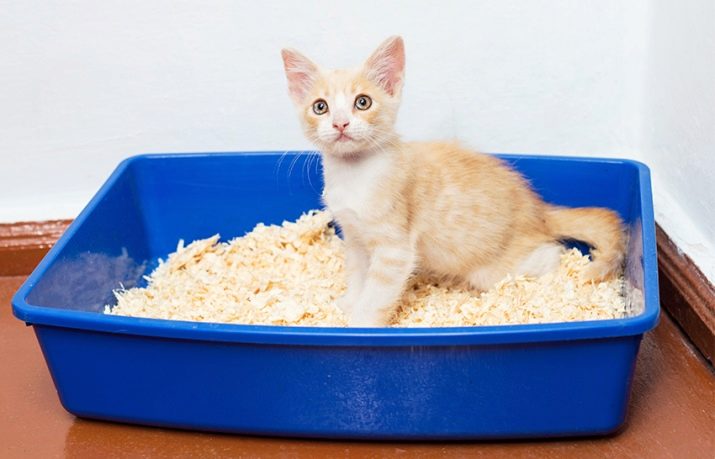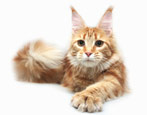Kittens born at home, aged 3-4 weeks, using their mother’s example, learn to use the toilet. Over time, they develop a habit and, getting to the new owners, the pets know that they need to defecate in the tray prepared for them. But if the animal was taken from the street, or came to you at a fairly early age, then you have to accustom it to the toilet yourself.

Site preparation
The modern market offers several types of cat trays. They vary in size, functionality and design. By type of toilets are divided into open and closed. In the first case, the product is a square or rectangular tray with sides along the perimeter. Some models have a removable mesh, which does not allow the pet to spread the filler on the floor.
Speaking of closed toilets, we mean that the design consists of a bottom and a lid, resembling a small house. Such a tray for most cats is more acceptable, it allows them to retire, and also prevents the scattering of the filler. But unlike an open structure, the closed one needs to be washed much more often, since pets can find it too dirty and do not want to defecate in it.
The fact is that an unpleasant odor is kept inside the tray, which causes hostility in such clean animals like cats.


For kittens, you should choose a large open tray with low sides. At first, it is better not to use a holding grid, since the baby instinctively needs to rummage through the filler. When he gets used to the toilet, you can install the grid.
When choosing a place for the tray, be sure to consider that it should be easily accessible and secluded. And also bowls for water and food of a pet should not be nearby. Quite often, the owners put a pot for a kitten in the toilet room, but for a baby it is not very convenient. While it is small, the tray needs to be positioned so that it is in sight, and it can be quickly and unhindered.

Filler Selection
In order for the cat to go to the tray with pleasure, it is necessary to choose a good filler for it. It should not have a pronounced smell, lumps or dust - for animals, such characteristics will be unpleasant and repulsive. In pet stores, you can purchase a filler of the following types:
- woody;
- mineral;
- corn;
- silica gel;
- paper.



The latter option is interesting in that the paper after the bowel movement of the pet changes color, which allows you to monitor the regular use of the tray for its intended purpose, and also helps to keep it clean.
For small kittens, at first it is best to use wood sawdust or paper, and when the baby develops a habit, you can try a fine mineral filler that resembles sand. This option will be pleasant for the pet and convenient for the owner. When wet, the granules hold the liquid in one place and change color. Therefore, the tray can be cleaned partially, removing only contaminated filler.

How to train an animal?
The kitten is accustomed to the tray gradually, and this process can take 1-2 weeks, so do not think that from the first day the baby will stop shitting in places not intended for the toilet. The owners should be attentive and patient with the pet, because it is also not easy for him.
First of all, you need to introduce the cat to the prepared tray, so that he looks around, gets used to the smell of filler. As a rule, animals become interested in a new object, and they are not even averse to lie down or play with it. It is recommended to clearly show him that in the filler you can "dig", but you need to do this with your fingers, and not the legs of the animal. From the first time, the pet is unlikely to use the tray for its intended purpose, since it does not yet know what it is for.
You need to constantly monitor the kitten, periodically put it on the pot, especially if it starts to behave strangely, as if looking for something or rushing around. Similar actions should be performed 30 minutes after eating. After the first successful results, do not rush to clean the tray - the smell of residues of stool will attract the baby, and the next time, most likely, the pet goes to the toilet in the same place.
After each successful visit to the tray, the kitten needs to be praised, but scolding for “misses” is not worth it. Places where the baby has spoiled should be thoroughly washed with detergents. If this is repeated several times, then put in that place bowls with food and water - cats will not spoil where they eat.

Using special tools
To simplify the task, the owners will be helped by a special tool for teaching a kitten to a tray called "Smart spray." Its smell attracts animals and signals that you can defecate in this place. The product is sprayed onto a piece of paper, which is placed in the tray, or directly sprayed onto the filler. After that, you need to bring the pet to the tray so that he gets acquainted with his toilet.
There are also means to protect places that are not intended for the toilet. Mostly they are also available in the form of a spray, but have a repulsive odor. With this tool you need to spray those places where the kitten is crap. It can be applied not only to the floor, but also to surrounding objects, for example, a sofa, a wall, a curbstone, curtains and so on.


All specialized products are completely safe for pets and in no way harm their health.
See how to properly train a kitten in a tray in the next video.


































